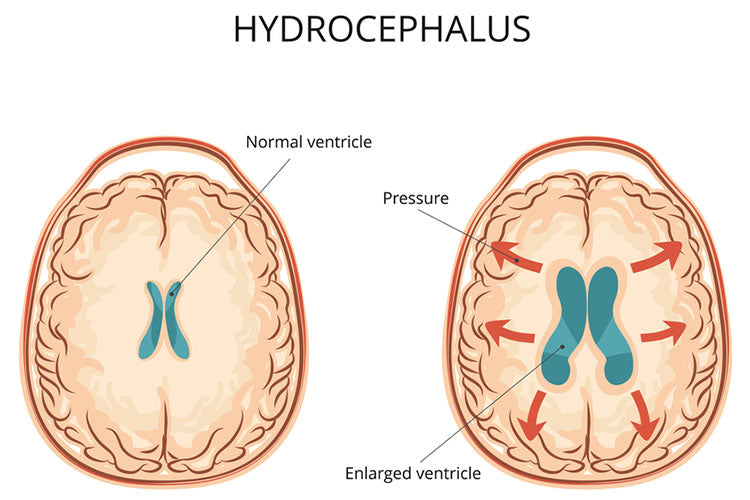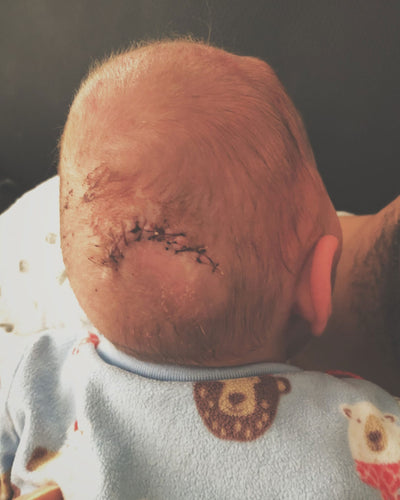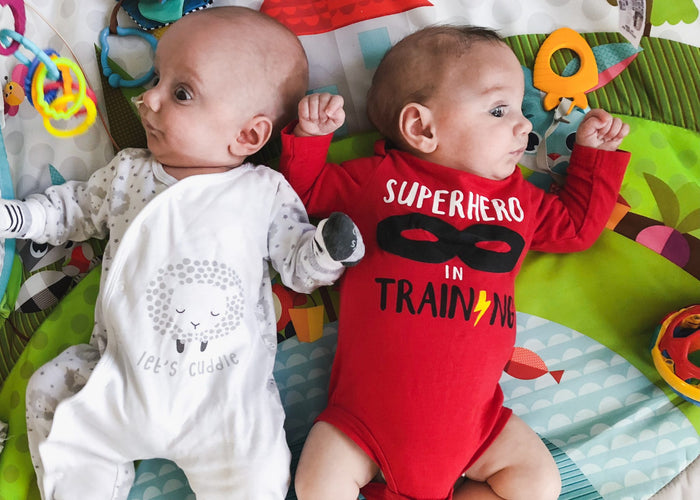I knew I wanted to raise awareness about TTTS (Twin to Twin Transfusion Syndrome) while I was still pregnant and undergoing monitoring for the condition, which only affects identical twin pregnancies (mono-di or mono-mono).
I felt the same about post-IVH hydrocephalus once the boys were born and it became one of their main health complications, which is for life.
We have been lucky enough to have been contacted by a few media outlets to share our story and help raise awareness! We are especially thankful to CBC Vancouver for featuring us on the news (video here) as well as writing about us online so we could reach a local audience.

What is TTTS?
TTTS, or Twin-to-Twin Transfusion Syndrome affects identical twin pregnancies, which are classified as either mono-di or mono-mono. That just means two babies who share one placenta. TTTS develops as a placental problem with blood flow between the twins. One twin gets too much blood/nutrients (the “recipient”) and the other doesn’t get enough (the “donor”).
So what happens usually is a size difference between the two with the donor becoming, predictably, smaller and not growing as fast as the recipient. TTTS usually presents first as an imbalance in amniotic fluid in each twin’s amniotic sac.
A typical range of fluid in each baby’s sac would be a DVP (deepest vertical pocket) measurement of 3-8cm. In TTTS, stage 1 is classified as when the donor’s fluid dips below 2cm and the recipient’s exceeds 8cm. (For example, my donor had 0.5-1cm most of the time and my recipient had 12-19cm!)
This diagram from SSM Health explains what that looks like for the babes:

There is no known cause of TTTS and it occurs randomly in 10-15% of identical twin pregnancies.
There are 5 stages to the disease, named after pioneering fetal surgeon Dr. Quintero:

Source: SlideShare/TotalPregnancyCare.com
The stages don’t have to be linear – you can go up and down as your pregnancy goes on. I was a Stage 1 from 18 – 27 weeks and then suddenly went straight to Stage 4 within 2 days (resulting in delivery at 27+2).
Monitoring Protocol for Identical Twin Pregnancies to Identify TTTS
If you are pregnant with identical twins, here is what you should know and advocate for yourself:
- You must be referred to a MFM (Maternal Fetal Medicine doctor) at 16 weeks, and scheduled for an ultrasound every 2 weeks at minimum.
- If TTTS is found, you will need more ultrasounds (I was going 2-3x a week).
- There are a few treatment options: laser ablation surgery which is the gold standard (more on that here). I was unable to get it due to my tricky anterior placenta and intertwin membrane. I had serial amnioreductions instead, though these have been associated with worse outcomes (clearly, in my case). Talk to your MFM about your case.
Do not go by what an OB, midwife or regular doctor says. You MUST see an MFM for this type of pregnancy, whether TTTS is present or not. You may have to advocate for yourself really hard to make this happen, even though it’s an internationally agreed-upon treatment protocol. Fight for your treatment!
If your OB still will not refer you at 16 weeks, show them this guideline document for ultrasound screening.
What is Post-IVH Hydrocephalus?
Alright, this is not a doctor-ey explanation. I’m going to keep it short and sweet here.
Hydrocephalus literally means “water on the brain/head”. Everyone’s brain is bathed in Cerebral Spinal Fluid (CSF). We produce it daily and it drains out of our brain (from the ventricles) and gets reabsorbed as waste product in the body. Hydrocephalus occurs when that fluid can’t drain out properly and gets trapped inside the ventricles. They get too full of fluid and begin to swell, eventually pressing on the brain and causing increased pressure and damage to the brain.
 Jaxon before his VP shunt surgery. You can see his swollen head.
Jaxon before his VP shunt surgery. You can see his swollen head.
There are a few causes of hydro: congenital (something happened during pregnancy to cause it in utero) or acquired. Both boys have acquired hydrocephalus, because they acquired it as a result of their brain bleeds that happened during/after birth.
IVH stands for Intraventricular Hemorrhage. That just means, bleeding in the brain coming from the ventricles.
Brain bleeds come in 4 grades:
- Grade I – bleeding occurs just in the germinal matrix
- Grade II – bleeding also occurs inside the ventricles, but they are not enlarged
- Grade III – ventricles are enlarged by the accumulated blood
- Grade IV – bleeding extends into the brain tissue around the ventricles
Axel had a Grade 3 on one side and a Grade 4 on the other, and Jaxon had a Grade 4 on both sides (the most severe). Both resulted in post-IVH hydrocephalus, though Jaxon’s was much more severe and required a temporary shunt at 15 days old, and 2 permanent VP shunts so far.
You can read more about Jaxon’s story with hydrocephalus and his brain surgeries here.
 Jaxon’s VP shunt from the back.
Jaxon’s VP shunt from the back.
Brain bleeds are, obviously, not good. They are associated with developmental problems, deafness and blindness, as well as other cognitive and physical conditions, most notably cerebral palsy. The higher the grade, the higher the risk, so it seems.
Post-IVH hydrocephalus is caused by a severe bleed, usually a 3 or 4. For lack of a better analogy, it plugs up the drain holes in the ventricles so the CSF fluid can’t get out properly. (Very scientific explanation, I know.)

Source: Ausmed.com
Treatment for hydrocephalus, regardless of the cause, is most often a VP shunt. This is a little device inserted into the ventricles of the brain that drains out the CSF fluid and runs it down a tube to the abdominal cavity where it drains out.

Source: childrensnational.org
The biggest problem with shunts for hydrocephalus? THEY FAIL.
Shunts are the highest failing medical device on the market, with a failure rate of 50%. There is no reason why they fail sometimes, they just do. Jaxon’s first VP shunt failed after only two weeks! It can be days, weeks, months or DECADES until one fails, but for someone with hydrocephalus which is a lifelong condition, their shunt WILL fail. It is only a matter of time.
When it does, the signs must be recognized quickly and the shunt replaced (which is another brain surgery).
You can find out more about shunts and hydrocephalus-related brain surgeries through the #NoMoreBS (No More Brain Surgeries) campaign from the Hydrocephalus Association.
How You Can Help
-
Donate to The TTTS Foundation
The TTTS Foundation, started by Mary Slaman, is the go-to resource online for identical twin moms to learn about TTTS and connect with others. Because of her Facebook group and website, I was able to learn what TTTS was, what care I needed to ensure I got, and met so many other women going through the same thing. This foundation is a LITERAL life-saver!
Mary also kindly sent me books about the NICU and preemies when my boys were born and admitted to the NICU. Those books were not only a kind gesture in a time of huge upheaval and emotions, but they really helped me understand the conditions my boys were going through.
Help fund Mary’s work in raising awareness of TTTS and also in taking care of us women with the condition by donating today! Click here to make an online donation.
2. Donate to the Hydrocephalus Association
The Hydrocephalus Association is a registered, non-governmental non-profit fully devoted to funding research for alternate treatments and a cure to hydrocephalus, as well as raising awareness for the condition.
3. Donate to your local NICU
Your local NICU is a great place to start to help out! It doesn’t have to be a cash donation. You could donate personal care packages for out-of-town families, like Take Care Kits does, or make jewelry or other items and donate partial proceeds to the NICU, like the beautiful bracelets from Book of Ethan (seriously gorgeous bracelets, and a strong mama).
It could also be something as simple as dropping off Christmas/holiday decorations or small gifts to families spending it in the NICU.
4. Start your own Facebook Fundraiser for free!
Did you know Facebook has a built-in fundraising feature? It’s so easy to set up and start. Here’s how.
- Login to Facebook on a desktop computer. (I’m not sure how to do this on mobile! If you know, write it in the comments below!)
- Look for the Fundraisers tab on the far left column.

Look for Fundraisers under Explore!
3. Click on Raise Money. Fill in the prompts that come up about your $ goal and why you’re raising money.
4. Click Create and you made it! Then just share it on your profile and ask friends and family to share it too.
How People Can Help Us 😊
We’re not real good at asking for help, even when we really need it.
I don’t like asking for help, especially financial help. I was in denial for a long time that we needed any. But, with spending many days at appointments downtown, the cost of medical supplies and Chris being on reduced hours for 5 months and then off work completely since August, it’s drained our small savings.

Taking care of these 2 medically complex boys is not something I can do alone right now. As it is, my husband and I still struggle with both of us devoted to them 24/7. We do not have nursing support or anything like that. I keep hoping it will get easier to manage so that I can do it alone and Chris can go back to work to help dig us out of debt. But so far, it hasn’t gotten easier.
So I’m ready to admit we need help. If you are so inclined, you can donate to our family here.
Or not!! Do not feel obligated at all. I cringe posting this.
Please know there are so many other ways to help us. For starters, I love and cherish all the friendships I’ve made here on Insta since the twins came. So many amazing moms! I love love love connecting with other medical/special needs moms and I cherish every thoughtful comment and well wishes people post here and on social media for us. That is a HUGE help on dark days. ❤️
Here are some other ways you can help us if you are unable to/don’t want to donate:
1. Send us thoughtful comments and prayers for the boys 😊🙌🏼
2. Come over and hold a baby or two so I can do things like cook and clean!
3. Bring us coffee.
4. Bring us wine.
5. Bring us whiskey… ok you get the idea with the beverages here.
6. Text me funny memes.
Do/did you have TTTS, or have a child with post-IVH hydrocephalus? Leave a comment below. I’d love to connect. ❤️




